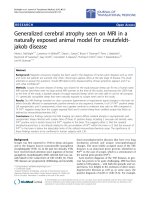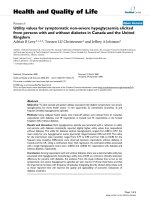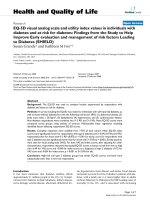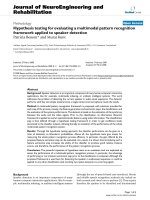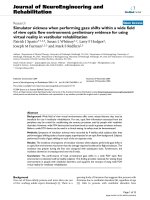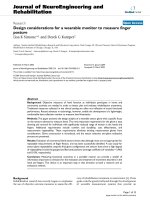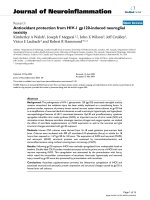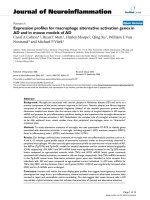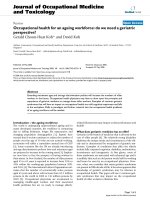báo cáo hóa học:" Brazilian Network for HIV Drug Resistance Surveillance: a survey of individuals recently diagnosed with HIV" pot
Bạn đang xem bản rút gọn của tài liệu. Xem và tải ngay bản đầy đủ của tài liệu tại đây (509.03 KB, 6 trang )
BioMed Central
Page 1 of 6
(page number not for citation purposes)
Journal of the International AIDS
Society
Open Access
Short report
Brazilian Network for HIV Drug Resistance Surveillance: a survey of
individuals recently diagnosed with HIV
Lilian A Inocencio
1
, Anderson A Pereira
1
, Maria Cecilia A Sucupira
2
,
José Carlos C Fernandez
3
, Célia P Jorge
4
, Denise FC Souza
1
, Helena T Fink
5
,
Ricardo S Diaz
2
, Irina M Becker
6
, Theodoro A Suffert
7
, MonicaBArruda
8
,
Olinda Macedo
8
, Mariangela BG Simão
1
and Amilcar Tanuri*
8
Address:
1
Brazilian DST/AIDS Program, Ministry of Health, Brasilia, DF, Brazil,
2
Lab de Retrovirologia, UNIFESP, Sao Paulo, SP, Brasil,
3
Lab de
Imunologia, IOC-FIOCRUZ, RJ, Brazil,
4
Laboratório de Biologia Molecular, UFBA, Salvador, BA, Brazil,
5
Public Health Lab (LACEN) Brasilia, DF,
Brazil,
6
Public Health Lab (LACEN), Porto Alegre, RS, Brazil,
7
Health Center Porto, Municipatility of Porto Alegre, Porto Alegre, RS, Brazil and
8
Lab Virologia Molecular, IB-UFRJ, Rio de Janeiro, RJ, Brazil
Email: Lilian A Inocencio - ; Anderson A Pereira - ; Maria Cecilia
A Sucupira - ; José Carlos C Fernandez - ; Célia P Jorge - ;
Denise FC Souza - ; Helena T Fink - ; Ricardo S Diaz - ;
Irina M Becker - ; Theodoro A Suffert - ;
Monica B Arruda - ; Olinda Macedo - ;
Mariangela BG Simão - ; Amilcar Tanuri* -
* Corresponding author
Abstract
Use of antiretrovirals is widespread in Brazil, where more than 200,000 individuals are under
treatment. Although general prevalence of primary antiretroviral resistance in Brazil is low,
systematic sampling in large metropolitan areas has not being performed.
The HIV Threshold Survey methodology (HIV-THS, WHO) was utilized, targeting Brazil's four
major regions and selecting the six most populated state capitals: Sao Paulo, Rio de Janeiro,
Salvador, Porto Alegre, Brasilia and Belem. We were able to sequence samples from 210 individuals
with recent HIV diagnosis, 17 of them (8.1%) carrying HIV isolates with primary antiretroviral
resistance mutations. Five, nine and four isolates showed mutations related to resistance to
nucleoside reverse transcriptase inhibitors (NRTIs), non-nucleoside reverse transcriptase
inhibitors (NNRTIs) and protease inhibitors (PIs), respectively. Using HIV-THS, we could find an
intermediate level of transmitted resistance (5% to 15%) in Belem/Brasilia, Sao Paulo and Rio de
Janeiro. Lower level of transmitted resistance (<5%) were observed in the other areas. Despite the
extensive antiretroviral exposure and high rates of virologic antiretroviral failure in Brazil, the
general prevalence of primary resistance is still low. However, an intermediate level of primary
resistance was found in the four major Brazilian cities, confirming the critical need to start larger
sampling surveys to better define the risk factors associated with transmission of resistant HIV.
Published: 18 September 2009
Journal of the International AIDS Society 2009, 12:20 doi:10.1186/1758-2652-12-20
Received: 2 May 2009
Accepted: 18 September 2009
This article is available from: />© 2009 Inocencio et al; licensee BioMed Central Ltd.
This is an Open Access article distributed under the terms of the Creative Commons Attribution License ( />),
which permits unrestricted use, distribution, and reproduction in any medium, provided the original work is properly cited.
Journal of the International AIDS Society 2009, 12:20 />Page 2 of 6
(page number not for citation purposes)
Findings
In the mid '90s, the Brazilian government took a major
step in the fight against HIV/AIDS, making antiretrovirals
available free to all infected individuals. In addition, a
strong prevention programme was established to curb
new infections. As a result of these strategies, AIDS-related
mortality rates, which peaked in 1995/6, have declined
continually, and the number of infected individuals stabi-
lized at lower figures, which contradicts earlier worst-case
predicted scenarios [1].
However, given the sequential use of antiretroviral drugs
in many patients at the beginning of this programme, the
proportion of patients experiencing virologic failure is
assumed to be high. In fact, one study, done in 2002 with
patients on treatment in 1999/2000, showed that the
median time for benefit of initial treatment was approxi-
mately 14 months among treatment-naïve patients [2].
Another study revealed that only 27.5% of patients main-
tained undetectable viral loads after one year of follow up.
With the introduction of new drugs and more potent reg-
imens, the level of efficacy of initial treatment increased
substantially in Brazil.
HIV primary and secondary antiretroviral resistance is of
major concern in a country such as Brazil, where there is
widespread access to antiretroviral therapy. A study con-
ducted in Brazil, which analyzed 2474 samples from
patients on highly active antiretroviral treatment and who
had virologic failure, showed that 95% presented with
mutations related to antiretroviral resistance and of them,
21%, 45% and 34% presented resistance to one, two or
three classes of antiretroviral drugs, respectively [3].
In contrast, the frequency of primary resistance is much
lower. Several independent surveys carried out in Brazil-
ian cities, which analyzed drug-naïve populations selected
from recently and chronically infected individuals,
showed resistance rates varying from 1.4% to 8.3% [4,5].
These numbers are not different from that observed in
developed countries, where transmission of resistant
viruses to one or more antiretroviral agent has been
reported since 1993.
For instance, surveys conducted in developed countries
during the past decade and targeting recent seroconverters
have shown prevalence rates of 10% to 17% in France,
13% in German, 14% in the United Kingdom, 15% to
26% in North America, and 23% to 26% in Spain [6-17].
Recent surveys performed in the USA and Europe in com-
parable populations pointed out a slight increase in pri-
mary resistance prevalence, especially to non-nucleoside
reverse transcriptase inhibitors (NNRTIs) [10]. A contrast
to this picture is the low prevalence of primary drug-resist-
ance mutation in South America and the Caribbean
(<4%) [18-20].
In order to monitor the transmission of drug-resistant
strains and the subtype profile in Brazil, a National Net-
work for Drug Resistance Surveillance (HIV-BResNet) in
the chronically infected drug-naïve population was estab-
lished in 2000. The first survey, done in 2001, showed an
overall primary resistance rate of 6.6% with even distribu-
tion of NRTI, NNRTI and protease inhibitor (PI) resist-
ance-related mutations [21]. Here, we describe the results
of a new HIV-BResNet survey, conducted in 2007/8 on
recently diagnosed HIV patients seeking treatment in
AIDS clinics located in six major cities.
Threshold Survey developed by the World Health Organ-
ization (WHO), was utilized to compare primary resist-
ance levels in patients in these cities. In this study, we
targeted the four major country regions by selecting the six
most populated state capitals (Sao Paulo, Rio de Janeiro,
Salvador, Porto Alegre, Brasilia and Belem), accounting
for more than 70% of the Brazilian HIV/AIDS epidemic
and the majority of patients under antiretroviral treat-
ment. The major clinical labs, where most recent diag-
nosed individuals have their first CD4+ T cell counts and
viral loads determinations, were selected to conduct the
patient selection, as well as genotypic analysis.
The inclusion criteria was homogeneous across the sites:
participating individuals had to have received their HIV
diagnosis in the past six months, not have been exposed
to antiretroviral drugs for any reason, and had to be more
than 18 years old. Individuals were selected to the study
and were invited to read and sign informed consents.
Samples were collected sequentially until 47 samples were
reached and the questionnaire was completed. Samples
were analyzed in the same order of inclusion in each site
and were amplified and sequenced. This study received an
institutional review board (IRB) approval (CONEP,
IRB#9772), and informed consents were obtained from
all participating individuals.
For genotypic analysis ViroSeq™ v2.0 (Celera Diagnostics,
Alameda, California, USA) or TrueGene™ (Siemens Diag-
nostics, USA) were used. Mutation lists, as well as FASTA
files generated by commercial software, were further eval-
uated according to published guidelines, which exclude
common polymorphisms [22]. For subtype assignment,
we first separated protease and reverse transcriptase cod-
ing regions and submitted the data to the Stanford HIVDR
website. For quality assurance purposes, we re-sequenced
10% of samples in target sites
The sample size and statistical approach from this survey
was adapted from WHO's HIV drug resistance Threshold
Journal of the International AIDS Society 2009, 12:20 />Page 3 of 6
(page number not for citation purposes)
Survey (HIV DR THS) protocol [23]. Each city or region
was treated as an independent sampling event, and a
binomial sequential strategy was utilized: 47 consecutive
HIV-positive specimens were collected and genotyped.
The HIV drug resistance prevalence can be categorized
into three different levels: low (<5%), moderate (5% to
10%), and high (>15%). The analysis can be stopped at
the 34 initial specimens if the prevalence can be catego-
rized as low (<5%, if n ≤ 1) or high (>15%, if n ≥ 6). If it
is not met, an additional 13 specimens need to be geno-
typed to precisely calculate the prevalence categories.
We were able to study 223 individuals in six sites. Their
clinical and demographic characteristics are depicted in
Table 1. The male:female ratio of our selected individuals
was 0.95:1.05, and the average age was 36 years old. The
average CD4+ T cell count was 577 cells/mm
3
, which sug-
gests that the selected individuals were in the initial,
asymptomatic stage of HIV infection.
We could successfully amplify and sequence 210 speci-
mens, and found 17 (8.1%) isolates carrying primary
drug-resistance mutations. Five, nine and four isolates
showed mutations related to resistance to NRTIs, NNRTIs
and PIs, respectively. The more prevalent were mutations
related to NNRTI (K103N and Y188L/I), followed by
NRTI and PI (Table 2). The main PI mutation found was
M46I (three individuals), followed by L90M (one individ-
ual). Interestingly, most PI mutations were found in Rio
de Janeiro. There was a clear geographic trend in primary
resistance. We found an intermediate level of transmitted
resistance (5% to 15%) in Belem/Brasilia, Sao Paulo and
Rio de Janeiro, contrasting with the other sites, where a
lower level of transmitted resistance (<5%) was observed.
Comparing this prevalence with the data obtained in the
BResNet survey performed in 2002, it can be observed
that the primary resistance in Brazil remains at a stable
level, 6.6% in 2002 versus 8.1 in this latest BResNet sur-
vey. In support of this fact, lower levels of transmitted
resistance have been detected in other surveys done in
major cities, such as Sao Paulo, Rio de Janeiro and Porto
Alegre [24-26]. On the other hand, other studies have
demonstrated distinct levels of transmitted resistance in
other geographic areas; for example, higher levels of pri-
mary resistance have been detected in Santos and Salva-
dor [27,28].
Table 1: Epidemiological and subtype distribution of individuals included in this survey
Epidemiological data Subtype distribution (%)
Characteristics Number B C F URF Others
Gender (male) 45% Sao Paulo (n = 47) 82 6 6 6 0
Age (years) 36 ± 8 Rio de Janeiro (n = 47) 87 2 2 9 0
Risk factor for HIV (%) Salvador (n = 34) 70 3 21 3 3
Homosexual 23.6 Porto Alegre (n = 34) 28 69 0 3 0
Bisexual 11 Belem/Brasilia (n = 48) 84 6 6 4 0
Heterosexual 56.1
Intravenous drug user 0
Blood transfusion 1.6
Other/multiple 8.7
Biological parameters
CD4 (cells/mm
3
)
a
575 ± 221
Viral load (log of copies/ml)
b
4.58 ± 4.75
a, and b
Calculation based on 187 and 156 individuals who responded to this item on the questionnaire, respectively.
Journal of the International AIDS Society 2009, 12:20 />Page 4 of 6
(page number not for citation purposes)
This study was not designed to evaluate the subtype distri-
bution and the sample size was very limited in each of the
sites sampled. However, we were able to observe that the
subtype distribution found closely reflects previous data
generated in Brazil. Subtype B was the more prevalent
subtype found in all cities sampled (72%), except for
Porto Alegre, where a large proportion of HIV-1 subtype C
was observed (69%). This rate seems higher than the rate
described in this city in HIV ResNet in 2002 (45%), sug-
gesting an increase of this non-B subtype in this country
region [21].
Subtype F and several BF mosaics as well Unique Recom-
binant Forms (URFs) are the other major non-B strain
spread throughout the country and corresponds to
approximately 13% of the samples analyzed in our study.
Interestingly, a CRF2 (A/G) isolate was found in Salvador
Bahia, corroborating previous reports regarding the intro-
duction of this west African strain in Brazil [29].
Some studies have demonstrated that the time to obtain a
viral load below the detection limit may be increased
among individuals with primary resistance [30]. Regard-
less of high antiretroviral exposure levels and high rates of
virologic antiretroviral failure found in Brazil, the general
prevalence of primary antiretroviral resistance is still low.
However, intermediate level of primary resistance was
found in our four major cities, suggesting that more
noticeable resistance is transmitted in these areas.
Of note, mutation K103N had a significant increase when
the rate observed in 2002 (0.24%) is compared to the one
found this study (3.3%; P < 0.001 chi-square). This fact
probably reflects the widespread use of efavirenz in the
first drug regimen in Brazil. Therefore, it is critical to start
larger sampling surveys to better define the risk factors
associated with transmission of primary resistance, as well
as strengthen the prevention programmes targeting HIV-
positive individuals in antiretroviral therapy. An increased
prevalence of K103N can be a risk in the long run for the
usage of NNRTI-based first-line antiretroviral regimens in
Brazil.
Competing interests
The authors declare that they have no competing interests.
Authors' contributions
MCS, JCF, CPJ, HF, IMB, TAS, MBA and OM carried out
the molecular genetic studies in the six states on BResNet.
AAP and DFCS participated in the sequence alignment.
AAP participated in the sequence alignment and subtype
analysis. RSD and AT participated in the design of the
study and performed the statistical analysis. LAI and
MBGS conceived of the study, participated in its design
Table 2: Genotypic distribution of primary mutations and level of resistance per site
Site Number of primary mutation found
NRTI NNRTI PI Level of Resistance
1
Sao Paulo (n = 3) 5%-15%
SP015 K103N M46I
SP022 K103N, K238T
SP041 K103N
Rio de Janeiro (n = 7) 5%-15%
RJ406 K103N
RJ529 L90M
RJ565 T69D
RJ578 T215E, K219R
RJ026 M46I
RJ064 M41L, T215C/S
RJ067 M46I
Brasilia/Belem (n = 3) 5%-15%
BE010 K103N
DF 058 M184V/M
Salvador (n = 1) < 5%
SA023 K103N
Porto Alegre (n = 1) < 5%
PA020 V82A
Journal of the International AIDS Society 2009, 12:20 />Page 5 of 6
(page number not for citation purposes)
and coordination, and helped to draft the manuscript. All
other authors in the HIV-BResNet Working Group are pro-
fessionals involved in the clinical and laboratories sites;
they participated in the coordination of this study at site
level. All authors read and approved the final manuscript.
Acknowledgements
This work was supported by the Brazilian Ministry of Health, UNESCO,
UNDOC, FAPERJ, FAPESP, CNPq, and CAPES. The HIV-BResNet Work-
ing Group is composed of: Gerson F.M. Pereira, Orival S Silveira (Programa
Nacional DST/AIDS Brazilian MoH); Carlos Brites (Salvador, BA); Gisele
Preusler, Ingrid Krilow, Maria da Gloria Correa, Sabrina Gilli, Lidia T Boul-
losa, Orlando C Ferreira Jr, Helena J Rosek (Porto Alegre, RS); Marcia CL
Rachid, Mariza G Morgado, Carlos S de-Jesus, Cydia AP Souza, Dirce B de
Lima, Jadir RF Neto, Sandra W Cardoso, José HS Pilotto, Beatriz Grinsztejn
(Rio de Janeiro, RJ); Nádia S Silva, Lya A Cherman, Maria C Abbate, Solange
MS Oliveira, Carmela Zaccaro, Rodrigo M. Côrtes (São Paulo, SP); Eider G
de Freitas (Brasília, DF); Elisabeth Santos (Belém, PA)
References
1. Teixeira PR, Vitória MA, Barcarolo J: Antiretroviral treatment in
resource-poor settings: the Brazilian experience. AIDS 2004,
18(Suppl 3):5-7.
2. Medeiros R, Diaz RS, Castelo A: Estimating the length of the first
antiretroviral therapy regiment durability in Sao Paulo, Bra-
zil. Braz J Infect Dis 2002, 6:298-304.
3. Caseiro MM, Golegã AAC, Etzel A, Diaz RS: Characterization of
virologic failure after an initially successful 48-week course of
antiretroviral therapy in HIV/AIDS outpatients treated in
Santos, Brazil. Brazilian Journal of Infectious Diseases 2008,
12:162-166.
4. De Medeiros LB, Lacerda HR, Cavalcanti AM, De Albuquerque M de-
F: Primary resistance of human immunodeficiency virus type
1 in a reference center in Recife, Pernambuco, Brazil. Mem
Inst Oswaldo Cruz 2006, 101:845-849.
5. Brígido LF, Nunes CC, Oliveira CM, Knoll RK, Ferreira JL, Freitas CA,
Alves MA, Dias C, Rodrigues R, Research Capacity Program: HIV
type 1 subtype C and CB Pol recombinants prevail at the cit-
ies with the highest AIDS prevalence rate in Brazil. AIDS Res
Hum Retroviruses 2007, 23:1579-1586.
6. Chaix ML, Harzic M, Masquelier B, Pellegrin I, Meyer L, Costagliola DI,
Rouzioux C, Brun-Vezinet F, Ac11 Resistance Group Cohort, Primo
and Primoferon Study Groups: Prevalence of genotypic drug
resistance among French patients infected during the year
1999. Eighth Conference on Retroviruses and Opportunistic Infections.
Chicago 2001:2-4.
7. Tamalet C, Pasquier C, Yahi N, Colson P, Martin LP, Lepeu G, Quin-
son AM, Poizot-Martin I, Dhiver C, Fantini J: Prevalence of drug
resistant mutants and virological response to combination
therapy in patients with primary HIV-1 infection. J Med Virol
2000, 61:181-186.
8. Duwe S, Brunn M, Altman D, Hamouda O, Schmidt B, Walter H, Pauli
G, Kücherer C: Frequency of genotypic and phenotypic drug-
resistant HIV-1 among therapy-naive patients from the Ger-
man seroconverter study. J Acquir Immune Defic Syndr 2001,
26:266-273.
9. UK Collaborative Group on Monitoring the Transmission of HIV
Drug Resistance: Analysis of prevalence of HIV-1 drug resist-
ance in primary infections in the United Kingdom. Br Med J
2001, 322:1087-1088.
10. Little SJ, Routy JP, Daar ES, Markowitz M, Collier AC, Koup RA, Con-
way B, Saag MS, Connick E, Holte S, Corey L, Keiser PH, Mwatha A,
Dawson K, Whitcomb JM, Hellmann NS, Richman DD:
Antiretrovi-
ral drug susceptibility and response to initial therapy among
recently HIV-infected subjects in North America. Antiviral
Ther 2001, 6(Suppl 1):21.
11. Boden D, Hurley A, Zhang L, Cao Y, Guo Y, Jones E, Tsay J, Ip J, Far-
thing C, Limoli K, Parkin N, Markowitz M: HIV-1 drug resistance
in newly infected individuals. JAMA 1999, 282:1135-1141.
12. Brodine SK, Shaffer RA, Starkey MJ, Tasker SA, Gilcrest JL, Louder
MK, Barile A, VanCott TC, Vahey MT, McCutchan FE, Birx DL, Rich-
man DD, Mascola JR: Drug resistance patterns, genetic sub-
types, clinical features, and risk factors in military personnel
with HIV-1 seroconversion. Ann Intern Med 1999, 131:502-506.
13. Briones C, Perez-Olmeda M, Rodriguez C, Romero J, Hertogs K,
Soriano V: Primary genotypic and phenotypic HIV-1 drug
resistance in recent seroconverters in Madrid. J Acquir Immune
Defic Syndr 2001, 26:145-150.
14. Weinstock H, Respess R, Heneine W, Petropoulos CJ, Hellmann S,
Luo CC, Pau CP, Woods T, Gwinn M, Kaplan J: Prevalence of
mutations associated with reduced antiretroviral drug sus-
ceptibility among human immunodeficiency virus type 1
seroconversters in the United States, 1993-1998. J Infect Dis
2000, 182:330-333.
15. Zaidi I, Weinstock H, Woods T, Petropoulos CJ, Hellmann NS, Luo
CC, Pau CP, Woods T, Gwinn M, Kaplan J: Prevalence of muta-
tions associated with antiretroviral drug resistance among
HIV-1-infected persons in 10 US cities, 1997-2000. Antiviral
Ther 2001, 6(Suppl 1):118.
16. Puig T, Perez-Olmeda M, Rubio A, Ruiz L, Briones C, Franco JM,
Gómez-Cano M, Stuyver L, Zamora L, Alvarez C, Leal M, Clotet B,
Soriano V: Prevalence of genotypic resistance to nucleoside
analogues and protease inhibitors in Spain. AIDS 2000,
14:727-732.
17. Gomez-Cano M, Rubio A, Puig T, Perez-Olmeda M, Ruiz L, Soriano
V, Pineda JA, Zamora L, Xaus N, Clotet B, Leal M: Prevalence of
genotypic resistance to nucleoside analogues in antiretrovi-
ral-naive and antiretroviral-experienced HIV-infected
patients in Spain. AIDS 1998, 12:1015-1020.
18. Kijak GH, Pampuro SE, Avila MM, Zala C, Cahn P, Wainberg MA,
Salomon H: Resistance profiles to antiretroviral drugs in HIV-
1 drug-naive patients in Argentina. Antiviral Ther 2001,
6:71-77.
19. Cesaire R, Dos Santos G, Abel S, Bera O, Sobesky G, Cabie A: Drug
resistance mutations among HIV-1 strains from antiretrovi-
ral-naive patients in Martinique, French West Indies. J Acquire
Immune Defic Syndr 1999, 22:401-405.
20. Delgado E, Leon-Ponte M, Villahermosa ML, Cuevas MT, Deibis L,
Echeverria G, Thomson MM, Pérez-Alvarez L, Osmanov S, Nájera R:
Analysis of HIV type 1 protease and reverse transcriptase
sequences from Venezuela for drug resistance-associated
mutations and subtype classification: A UNAIDS study. AIDS
Res Hum Retroviruses 2001, 17:753-758.
21. Brindeiro RM, Diaz RS, Sabino EC, Morgado MG, Pires IL, Brigido L,
Dantas MC, Barreira D, Teixeira PR, Tanuri A, Brazilian Network for
Drug Resistance Surveillance: Brazilian Network for HIV Drug
Resistance Surveillance (HIV-BResNet): a survey of chroni-
cally infected individuals. AIDS 2003, 17:1063-1069.
22. Bennett DE, Camacho RJ, Otelea D, Kuritzkes DR, Fleury H, Kiuchi
M, Heneine W, Kantor R, Jordan MR, Schapiro JM, Vandamme AM,
Sandstrom P, Boucher CA, Vijver D van de, Rhee SY, Liu TF, Pillay D,
Shafer RW: Drug resistance mutations for surveillance of
transmitted HIV-1 drug-resistance: 2009 update. PLoS ONE
2009, 4:e4724.
23. Myatt M, Bennett DE: A novel sequential sampling technique
for the surveillance of transmitted HIV drug resistance by
cross-sectional survey for use in low resource settings. Antivir
Ther 2008, 13(Suppl 2):37-48.
24. Gonsalez CR, Alcalde R, Nishiya A, Barreto CC, Silva FE, de Almeida
A, Mendonça M, Ferreira F, Fernandes SS, Casseb J, Duarte AJ: Drug
resistance among chronic HIV-1-infected patients naïve for
use of anti-retroviral therapy in Sao Paulo city. Virus Res 2007,
129:87-90.
25. Pires IL, Soares MA, Speranza FA, Ishii SK, Vieira MC, Gouvêa MI,
Guimarães MA, de Oliveira FE, Magnanini MM, Brindeiro RM, Tanuri
A: Prevalence of human immunodeficiency virus drug resist-
ance mutations and subtypes in drug-naive, infected individ-
uals in the army health service of Rio de Janeiro, Brazil. J Clin
Microbiol 2004, 42:426-430.
26. Rodrigues R, Scherer LC, Oliveira CM, Franco HM, Sperhacke RD,
Ferreira JL, Castro SM, Stella IM, Brigido LF: Low prevalence of pri-
mary antiretroviral resistance mutations and predominance
of HIV-1 clade C at polymerase gene in newly diagnosed indi-
viduals from south Brazil. Virus Res 2006, 116:201-217.
27. Sucupira MC, Caseiro MM, Alves K, Tescarollo G, Janini LM, Sabino
EC, Castelo A, Page-Shafer K, Diaz RS: High levels of primary
antiretroviral resistance genotypic mutations and B/F
Publish with BioMed Central and every
scientist can read your work free of charge
"BioMed Central will be the most significant development for
disseminating the results of biomedical research in our lifetime."
Sir Paul Nurse, Cancer Research UK
Your research papers will be:
available free of charge to the entire biomedical community
peer reviewed and published immediately upon acceptance
cited in PubMed and archived on PubMed Central
yours — you keep the copyright
Submit your manuscript here:
/>BioMedcentral
Journal of the International AIDS Society 2009, 12:20 />Page 6 of 6
(page number not for citation purposes)
recombinants in Santos, Brazil. AIDS Patient Care STDS 2007,
21:116-128.
28. Pedroso C, Queiroz AT, Alcântara LC, Drexler JF, Diaz RS, Weyll N,
Brites C: High prevalence of primary antiretroviral resistance
among HIV-1-infected adults and children in Bahia, a north-
east state of Brazil. J Acquir Immune Defic Syndr 2007, 45:251-253.
29. Eyer-Silva WA, Morgado MG: Autochthonous horizontal trans-
mission of a CRF02_AG strain revealed by a human immun-
odeficiency virus type 1 diversity survey in a small city in
inner state of Rio de Janeiro, Southeast Brazil. Mem Inst
Oswaldo Cruz 2007, 102:809-815.
30. Little SJ, Smith DM: HIV treatment decisions and transmitted
drug resistance. Clin Infect Dis 2005, 41:233-235.

